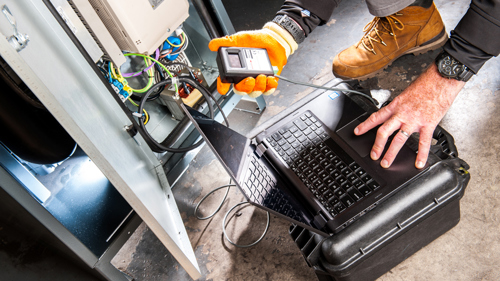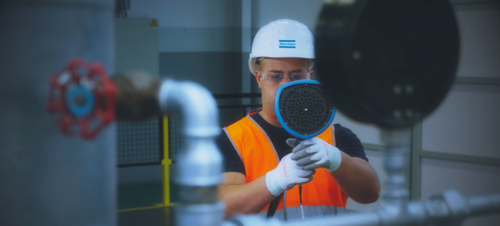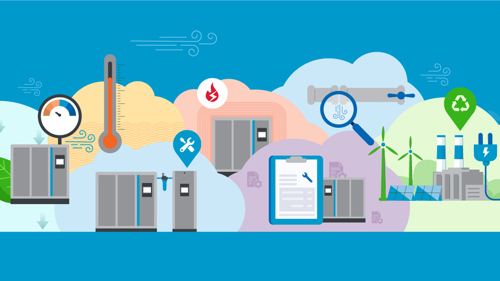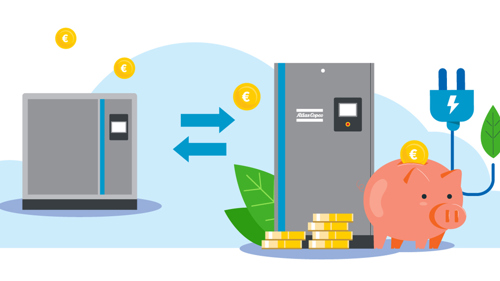Byline: Gareth Lees, Optimisation Manager, Atlas Copco Compressors
Reducing energy consumption has never have been more important. With energy prices at an all-time high, using less energy can deliver big savings. Controlling energy usage can also deliver production efficiencies, contributing to a more sustainable business operation.
About 10% of the world’s energy is used for compressing air, so this should be a prime focus for any business wanting to reduce its carbon footprint. In addition, energy represents around 80% of the lifetime cost of your compressor, so compressed air efficiency is the number one priority to substantially reduce your operational costs.
Atlas Copco offers the following seven recommendations to curb energy use when compressing air. Some of these recommendations are easy and quick to implement. Others require some investment: but the energy savings mean that these interventions will quickly pay for themselves.

1. Reduce your air pressure
Reducing air pressure not only saves energy and reduces cost, but can also extend the maintenance intervals for seals or diaphragms because they will be subjected to less stress. If your compressed air system produces 10 bar of pressure but it only takes 7 bar to power your equipment, then you are wasting 3 bar. That might not seem like a lot, but the impacts are cumulative. For every bar that you lower the pressure of your compressed air system, your energy consumption will go down by about 7%. Frequent evaluation of your system requirements will deliver the best results.
If you own multiple compressors, consider using a smart central controller, which will ensure that each compressor delivers the correct pressure to multiple applications (if the applications require different pressure setpoints). This solution also eliminates pressure reducers, which would otherwise waste energy. Another way to reduce your pressure setpoint is to review your air distribution system. Small diameter piping, excessive bends, couplings, filters, and pressure reducers have a big impact on the total pressure drop of a system. Seek opportunities to increase the diameter where necessary, remove pressure reducers and increase the size of installed filter packages. And don't forget to reduce your pressure set point to enable those savings afterwards.

2. Eliminate air leakages
Almost every compressed air system has leaks – and these can be very costly. Most compressed air users do not realize that up to 30% of their energy – and an average of 20% – is lost due to leaks in their piping. Quite literally, this is your money vanishing into thin air.
There are many ways to pinpoint leakage. They range from highly sophisticated scanners to low-technology methods. For example, you can simply apply soapy water to areas in which you suspect leaks. If there is a leak, you will see the formation of bubbles. Another simple solution is to isolate unused tools to eliminate leaks inside this equipment. The most accurate method is using ultrasonic air leak detection equipment. This operates without interrupting plant operation, reaches system areas that are hard to access, and locates all air leaks and reports the results, allowing maintenance teams to quickly locate and prioritise repairs based on the severity of the leaks.

3. Optimise your ambient temperature
Ambient temperature plays a major role in keeping your energy bill low. For every reduction of 5°C, you can achieve energy savings of 1.5%.
Indeed, the conditions in your compressor room – or the room in which your compressor is located – make a major difference to the performance of the equipment. Make sure that you run your compressors in clean, cool, and well-ventilated environments. Keep the air in the room free from dust and moisture to ensure that the compressed air is not contaminated and doesn’t have to be treated more than necessary. Eliminating the need for aftercoolers, dryers and filters also saves energy. Another possibility is getting your intake air from the outside, especially in cooler environments.
4. Perform regular maintenance
Regular check-ups and energy audits not only extend the lifespan of your compressed air equipment but also help make it more efficient. This type of maintenance optimises the performance of the entire system, which reduces the amount of energy it consumes. One great example of this is that regularly replacing wear parts will reduce leaks, while periodic inspections will help detect them.
But don’t just wait to perform maintenance when it is scheduled. Many tools and technologies are now available that will allow you to carry out predictive and preventive maintenance to keep your compressors in the best possible working order.

5. Respect the service life of your machine
No matter how well you maintain your compressed air equipment, its effectiveness and efficiency will diminish over time. Hanging on to older machines is a false economy because they get more expensive to operate – both in terms of energy consumption and upkeep costs. In addition, you will fail to take advantage of the improvements that are being made all the time in compressor technology, such as the evolution of variable speed drive (VSD) technology.
Over 25 years ago, Atlas Copco introduced the first compressor whose motor speed would automatically adjust to the air demand. This resulted in energy savings of 35% over conventional fixed-speed compressors. The latest version of these compressors – the GA VSDS series – can reduce your compressor’s energy consumption by up to 60%. So, while some businesses may shy away from making new investments, especially at a time of high energy prices, new and more efficient equipment will often pay for itself very quickly because your operating expenses decrease.
6. Recover heat
Compressing air not only consumes a lot of energy, but it also generates a lot of heat. You could simply allow this heat to go to waste (if you do, at least make sure it is not released inside your compressor room to keep the ambient temperature low - see point 3). A better alternative is to harness this heat, effectively reusing the power consumed during the compression process to reduce your energy bill. The recovered heat can be used for a variety of different applications, such as heating water, replacing furnaces or in drying processes.
In many cases, heat recovery does not require major investment. For example, you can simply connect the compressor hot outlet to your HVAC ducting in the winter to heat your facilities, or you could install an energy recovery kit and heat up water for use elsewhere in your facilities.
7. Use green energy
There is no way around the fact that compressing air uses quite a bit of energy – at least not yet. However, what you can do is make sure that all or most of it is green energy. This may involve installing solar panels or wind turbines to power your production (this recommendation is obviously not limited to your compressed air equipment). While this can constitute a significant investment, many governments will now subsidise renewable energy installations as part of their climate protection strategy. On-site renewables can certainly lower your costs and significantly reduce your CO2 output. Talking to the experts and doing the maths will prove whether this is a good investment.
Next steps
If you want to reduce your compressed air consumption but are unsure where to start, Atlas Copco offers its AIRchitect service, which is free to any compressed air user. We will monitor your compressed air usage for 7-10 days. Using the collected data, our experts compile a comprehensive report tailored specifically to your operation. That means there are no generic suggestions, just real recommendations on how you can save energy. It’s entirely up to you whether you then implement them.
For more information, read Atlas Copco’s eBook ‘7 easy ways to reduce your air compression costs’ https://www.atlascopco.com/en-uk/compressors/guides-and-ebooks/ebook-green-production












National Gas receives funding to develop Gravitricity underground hydrogen storage system
One single rock salt mine - Winsford - has 23 <i>MILLION </i>cubic metres of void and even allowing for 10% of that void set aside for hazardous waste...